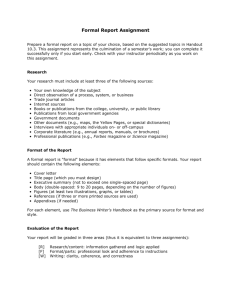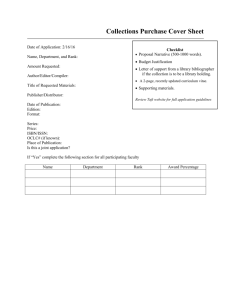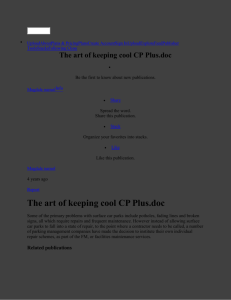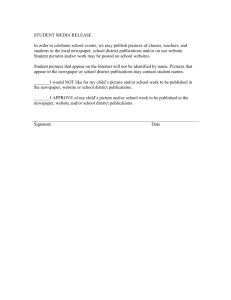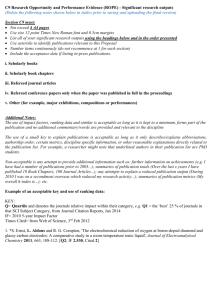Publications Officer's Guide
advertisement
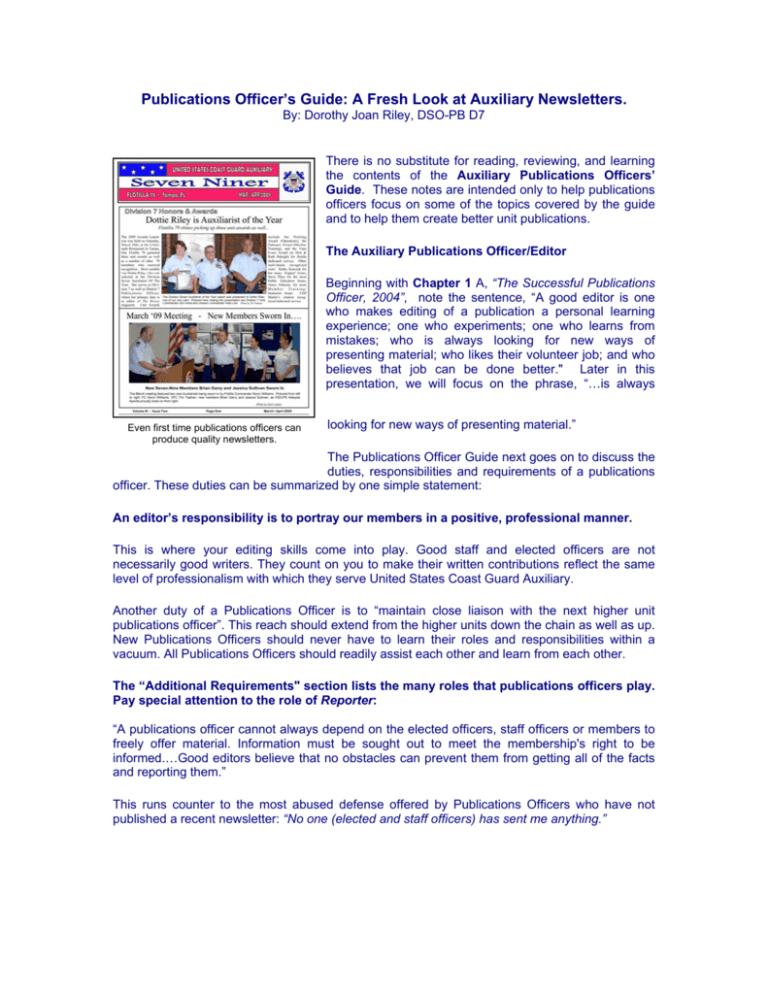
Publications Officer’s Guide: A Fresh Look at Auxiliary Newsletters. By: Dorothy Joan Riley, DSO-PB D7 There is no substitute for reading, reviewing, and learning the contents of the Auxiliary Publications Officers’ Guide. These notes are intended only to help publications officers focus on some of the topics covered by the guide and to help them create better unit publications. The Auxiliary Publications Officer/Editor Beginning with Chapter 1 A, “The Successful Publications Officer, 2004”, note the sentence, “A good editor is one who makes editing of a publication a personal learning experience; one who experiments; one who learns from mistakes; who is always looking for new ways of presenting material; who likes their volunteer job; and who believes that job can be done better." Later in this presentation, we will focus on the phrase, “…is always Even first time publications officers can produce quality newsletters. looking for new ways of presenting material.” The Publications Officer Guide next goes on to discuss the duties, responsibilities and requirements of a publications officer. These duties can be summarized by one simple statement: An editor’s responsibility is to portray our members in a positive, professional manner. This is where your editing skills come into play. Good staff and elected officers are not necessarily good writers. They count on you to make their written contributions reflect the same level of professionalism with which they serve United States Coast Guard Auxiliary. Another duty of a Publications Officer is to “maintain close liaison with the next higher unit publications officer”. This reach should extend from the higher units down the chain as well as up. New Publications Officers should never have to learn their roles and responsibilities within a vacuum. All Publications Officers should readily assist each other and learn from each other. The “Additional Requirements" section lists the many roles that publications officers play. Pay special attention to the role of Reporter: “A publications officer cannot always depend on the elected officers, staff officers or members to freely offer material. Information must be sought out to meet the membership's right to be informed.…Good editors believe that no obstacles can prevent them from getting all of the facts and reporting them.” This runs counter to the most abused defense offered by Publications Officers who have not published a recent newsletter: “No one (elected and staff officers) has sent me anything.” Newsletters as House Organs A unit newsletter is a house organ. A house organ is designed to build loyalty and promote an organization and its products or services by communicating with interested individuals and groups.* *The American Heritage® Dictionary of Business Terms Copyright © 2009 by Houghton Mifflin Harcourt Publishing Company. Published by Houghton Mifflin Harcourt Publishing Company. While Auxiliary newsletters do not promote products or services, they do promote loyalty, our great organization and its members. House organs are traditionally more relaxed than newspapers and often do not conform to the AP Stylebook as rigidly as civilian newspapers. Examples are the absence of datelines and the use of some acronyms such as FC and VFC. While we urge editors to spell out all acronyms upon first use in every article, we acknowledge that this is not always practical or reasonable. The best rules to follow are the rules of common sense. Functions of a Newsletter A newsletter satisfies the member’s right to be informed by publishing news, reports, program updates and articles of interest; however, it is one of the best vehicles available to us to applaud our members’ efforts. As an all-volunteer organization, the only acknowledgment we receive for our contributions is through awards, certificates and recognition in our unit publications. Auxiliary Newsletters: Producing a Unit Publication Please review Chapters 1 and 4 of the Publications Officer Guide covering what to print, ethics, libel, plagiarism, copyright, and approval. Two points to remember: While we encourage editors to reprint articles of special interest that appear in other publications, you must obtain the written permission of the author or publisher before printing to avoid copyright infringement. You may use material from any of the Coast Guard or Auxiliary publications and manuals, but always provide proper credit. Copyright covers all writing, printing, engraving, etching, photographs, cartoons and graphic representations. Basic editing tasks include correcting errors in facts, spelling, grammar, punctuation, and word usage for both meaning and connotation. Chapter 7 of the Publications Officers’ Guide provides a basic guide to the rules of capitalization, abbreviations, and grammar, while Chapter 6 provides writing tips and other aids for the editor. Other books and publications useful for a Publications Officer include a Handbook for Writers, and the Associated Press Stylebook. Several printing houses of textbooks offer a Handbook for Writers and used editions can be found quite cheaply on the Internet. 2 Required Elements of the Newsletter The following information should always appear on the publication masthead, if one is used, or on the cover: • • • • Name of publication Date of publication District or region (flotilla and location) and unit number (flotilla or division). Editor’s name and telephone number must appear somewhere in the issue, preferably on the first page inside Other information to include: The name, address and telephone number of the highest elected officers is suggested, but not required. The editor must obtain permission from this officer before listing personal contact information. Privacy Act Notice While it is not a required element, we recommend including the Privacy Act Statement. Our newsletters are available to the public online. This notice may act as a deterrent to unauthorized use of newsletter content by placing the public on notice. Sample statement: The Privacy Act of 1974 protects names, addresses, telephone/fax numbers and e-mail addresses of Auxiliary members which may appear in this or other USCGAUX publications. As a matter of policy, information described above is not made available to the general public or outside groups without that member’s express and/or written consent. When such information appears, its privacy shall be safeguarded and the information will be clearly labeled. Publication of this information by the general public and/or outside groups is prohibited by the Privacy Act. Chapter 4 summarizes what does and does not go into the unit newsletter. Please do not include: • • • • Birthday, wedding and vacation announcements Purely society page items Recipes Items for sale by members The Mechanics of Copy Preparation and Layout (Chapter 2) Every desktop publishing program offers one or more templates for newsletters. Publications Officers are encouraged to adapt one of these templates when creating and producing their newsletters. The makers of software spend thousands of dollars paying professional graphic artists to create these templates, and it is in our interest to capitalize on their investment. Use properly credited photographs to break up large blocks of text 3 Proofread every issue before publication… the more often, and by the most pairs of eyes, the better! Remember the phrase, “(the Publications Officer)… is always looking for new ways of presenting material?” Here are some points to keep in mind: • • • • While newspapers trained us to scan the first few paragraphs with the pyramid reporting style, the web has retrained us to look for relevant material within just a few words. What has become true of all forms of media is that we have become more visually oriented. Good photographs and great graphic presentations draw in our eyes and interests. To take the best advantage of this phenomenon, we should use photographs when they are available, and write interesting headlines and great lead sentences. A poor or uninteresting presentation may cause readers to overlook important information and critical program updates. Every unit newsletter should be interesting and informative. To accomplish this, editors need to be resourceful and creative… and not be afraid to experiment with presentation methods! Where to Find Templates All desktop publishing programs come with newsletter templates. Prepackaged, cheaper office utility programs such as Microsoft Works® offer templates. Templates that work with a variety of programs can be found free online. Adjust the template to suit your needs. Most elements within a template can be changed including typefaces, picture locations, column widths and logos. The number of columns you use, or whether you justify columns or left indent are personal design choices. Save the newly created template as a ‘master’ and use it to start each new issue. As soon as you start an issue, remember to save it with a new/different file name. Principles of Design- UVBE Theories about design principles abound. One of the most often taught is the principle of ‘UVBE’: • • • • Unity- Repetition. Consistency. Do all the elements work together visually? Variety- Creative use of white space, images and accents to break up large blocks of text. Balance- Harmony. Equilibrium. Proportion. Emphasis - Does your design draw attention to what is important? 4 Principle of Design- ‘CCC’ A second and more readily understood and applied theory of design is ‘CCC’. • • • Consistency- Unity of design elements page to page, issue to issue. Contrast- Variety is created by design elements including the creative use of white space, images and accent blocks to break up columns of text. Correctness- Correctness in content, copy and images cannot be over stated. While the intended audience of every newsletter is the members, it also serves as a reflection of your flotilla or division. A less than professional presentation is not a good reflection of your unit. Methods of Reproduction and Distribution Due to advances in desktop publishing, a variety of reproduction methods are available. The most commonly used method is electronic distribution. This method offers great savings to units as distribution can be made via e-mail or by posting the newsletter on a flotilla’s webpage. As this method is cost-effective, we strongly encourage all units to post their newsletters on their division and flotilla websites. Units that choose to mail hard copies should pay special attention to the strict guidelines set out for use of the Penalty Mail Stamp System (Chapter 3). Newsletters distributed via the web need to print at least two paper copies--- one for DIRAUX, and one for the Joiner Library. Chapter 3 of the Publications Officers’ Guide covers in detail everything publication officers need to know about the distribution of newsletters including, but not limited to, the use of the Penalty Mail Stamp System and the recommended distribution list. Always include your SO-PB, ADSOPB and DSO-PB. Be sure to include the local active duty Coast Guard unit personnel. This will help to build and maintain strong ties to the local units, keep them informed of our activities, and remind them that the Auxiliary can be a valuable resource for them. Awards for Your Publication (Chapter 5) The 2009 District 7 Newsletter Competition followed the guidelines set forth by the Publications Officers’ Guide and by the National Public Affairs Department’s 2009 Awards notification. Our D7 Public Affairs team headed by Tom Loughlin, DSO-PA, graciously consented to judge this year’s entries. A copy of the score sheet for the 2009 District 7 newsletter competition is attached to help our PB officers better understand what the judges evaluated. Possibly the best purpose served by the Publications Contest is to make editors aware of newsletter standards. This knowledge should translate into improved publications for our members.O 5 The 2009 District 7 Publications Contest Winners are: Division: First Place Division 7, Intercom Editor: Dorothy Riley Second Place Division 8, Pieces of Eight Editor: Paulette Parent Third Place Division 2, Baggywrinkle Editor: Philip Yost Flotilla: First Place Flotilla 98, Harbor Light Editor: Duane Ising Second Place Flotilla 46, The Weather Deck Editor: William Giers Third Place Flotilla 86, Fore and Aft Editor: Judi Bidwick We encourage you to go to their websites and look at these winning publications. Division and flotilla websites are accessed through the links in the District 7 website under ‘Divisions’. 6 Newsletter Competition District 7 Grading: 1 to 5 with 5 being the highest score Appearance 5 4 3 2 1 Required Elements/ Contents*1 Name of publication Date of publication District or Region (Flotilla add location) Unit number Editor’s name and address Editorial quality Correct titles of Auxiliarists, etc. Correct abbreviations Correct usage of grammar and punctuation Photos – i.e., Auxiliarists in proper uniform, etc. Persons depicted are properly identified Proper photo credits Information quality Critical program updates and articles of interest Attention to flotilla, division, district and National functions Unit commander comments or column Correct number of issues published and submitted to Awards Committee*2 Incorrect number of copies published/ submitted disqualifies entry x x x x x *1 This information may appear on the front page or the masthead. *2 Please note that per National submission guidelines, eligible publications may fall outside a single calendar year. Please review the PB Officer's Guide For more specific information 7
